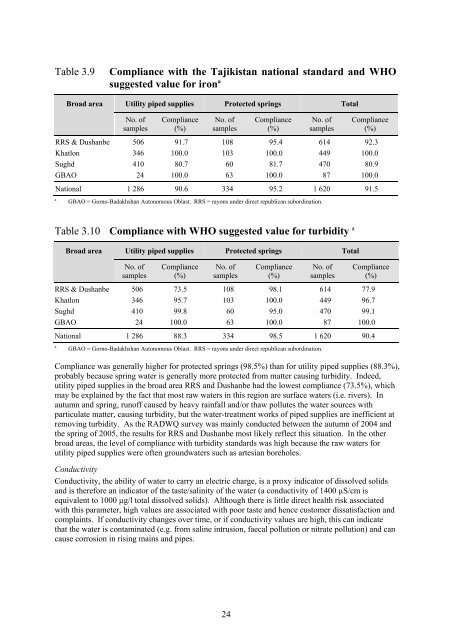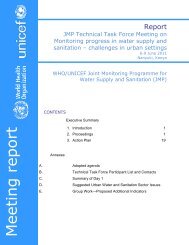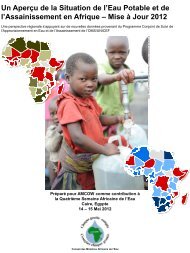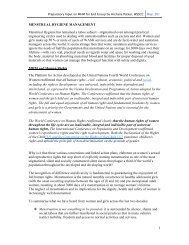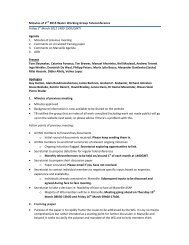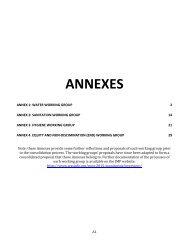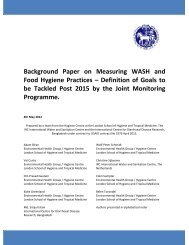rapid assessment of drinking-water quality in the republic of tajikistan
rapid assessment of drinking-water quality in the republic of tajikistan
rapid assessment of drinking-water quality in the republic of tajikistan
You also want an ePaper? Increase the reach of your titles
YUMPU automatically turns print PDFs into web optimized ePapers that Google loves.
Table 3.9<br />
Broad area<br />
Compliance with <strong>the</strong> Tajikistan national standard and WHO<br />
suggested value for iron a<br />
Utility piped supplies Protected spr<strong>in</strong>gs Total<br />
No. <strong>of</strong><br />
samples<br />
Compliance<br />
(%)<br />
No. <strong>of</strong><br />
samples<br />
Compliance<br />
(%)<br />
No. <strong>of</strong><br />
samples<br />
Compliance<br />
(%)<br />
RRS & Dushanbe 506 91.7 108 95.4 614 92.3<br />
Khatlon 346 100.0 103 100.0 449 100.0<br />
Sughd 410 80.7 60 81.7 470 80.9<br />
GBAO 24 100.0 63 100.0 87 100.0<br />
National 1 286 90.6 334 95.2 1 620 91.5<br />
a<br />
GBAO = Gorno-Badakhshan Autonomous Oblast. RRS = rayons under direct <strong>republic</strong>an subord<strong>in</strong>ation.<br />
Table 3.10 Compliance with WHO suggested value for turbidity a<br />
Broad area<br />
Utility piped supplies Protected spr<strong>in</strong>gs Total<br />
No. <strong>of</strong><br />
samples<br />
Compliance<br />
(%)<br />
No. <strong>of</strong><br />
samples<br />
Compliance<br />
(%)<br />
No. <strong>of</strong><br />
samples<br />
Compliance<br />
(%)<br />
RRS & Dushanbe 506 73.5 108 98.1 614 77.9<br />
Khatlon 346 95.7 103 100.0 449 96.7<br />
Sughd 410 99.8 60 95.0 470 99.1<br />
GBAO 24 100.0 63 100.0 87 100.0<br />
National 1 286 88.3 334 98.5 1 620 90.4<br />
a<br />
GBAO = Gorno-Badakhshan Autonomous Oblast. RRS = rayons under direct <strong>republic</strong>an subord<strong>in</strong>ation.<br />
Compliance was generally higher for protected spr<strong>in</strong>gs (98.5%) than for utility piped supplies (88.3%),<br />
probably because spr<strong>in</strong>g <strong>water</strong> is generally more protected from matter caus<strong>in</strong>g turbidity. Indeed,<br />
utility piped supplies <strong>in</strong> <strong>the</strong> broad area RRS and Dushanbe had <strong>the</strong> lowest compliance (73.5%), which<br />
may be expla<strong>in</strong>ed by <strong>the</strong> fact that most raw <strong>water</strong>s <strong>in</strong> this region are surface <strong>water</strong>s (i.e. rivers). In<br />
autumn and spr<strong>in</strong>g, run<strong>of</strong>f caused by heavy ra<strong>in</strong>fall and/or thaw pollutes <strong>the</strong> <strong>water</strong> sources with<br />
particulate matter, caus<strong>in</strong>g turbidity, but <strong>the</strong> <strong>water</strong>-treatment works <strong>of</strong> piped supplies are <strong>in</strong>efficient at<br />
remov<strong>in</strong>g turbidity. As <strong>the</strong> RADWQ survey was ma<strong>in</strong>ly conducted between <strong>the</strong> autumn <strong>of</strong> 2004 and<br />
<strong>the</strong> spr<strong>in</strong>g <strong>of</strong> 2005, <strong>the</strong> results for RRS and Dushanbe most likely reflect this situation. In <strong>the</strong> o<strong>the</strong>r<br />
broad areas, <strong>the</strong> level <strong>of</strong> compliance with turbidity standards was high because <strong>the</strong> raw <strong>water</strong>s for<br />
utility piped supplies were <strong>of</strong>ten ground<strong>water</strong>s such as artesian boreholes.<br />
Conductivity<br />
Conductivity, <strong>the</strong> ability <strong>of</strong> <strong>water</strong> to carry an electric charge, is a proxy <strong>in</strong>dicator <strong>of</strong> dissolved solids<br />
and is <strong>the</strong>refore an <strong>in</strong>dicator <strong>of</strong> <strong>the</strong> taste/sal<strong>in</strong>ity <strong>of</strong> <strong>the</strong> <strong>water</strong> (a conductivity <strong>of</strong> 1400 µS/cm is<br />
equivalent to 1000 µg/l total dissolved solids). Although <strong>the</strong>re is little direct health risk associated<br />
with this parameter, high values are associated with poor taste and hence customer dissatisfaction and<br />
compla<strong>in</strong>ts. If conductivity changes over time, or if conductivity values are high, this can <strong>in</strong>dicate<br />
that <strong>the</strong> <strong>water</strong> is contam<strong>in</strong>ated (e.g. from sal<strong>in</strong>e <strong>in</strong>trusion, faecal pollution or nitrate pollution) and can<br />
cause corrosion <strong>in</strong> ris<strong>in</strong>g ma<strong>in</strong>s and pipes.<br />
24


